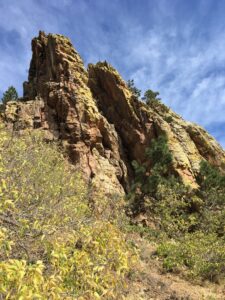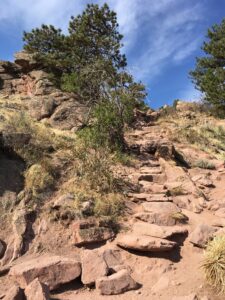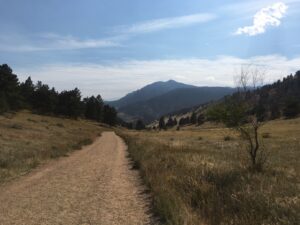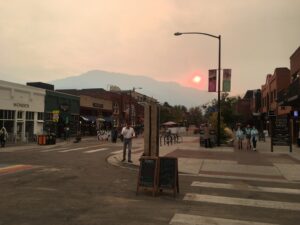
On our last full day in Boulder, we made good on our word and got an earlier start than usual. We quickly stopped at a coffee shop called Amante (it was fine; nothing spectacular) and then made our way to the Mount Sanitas Trailhead off of Sunshine Canyon Drive on Boulder’s west side. This hike came highly recommended from our friends, Bob and Stacy, who described the hike in an email as a “fairly steep climb.” It’s also another hike that I’d recommend you save for later in your visit to Boulder, as–like the hike through the Flatirons–it’s a quite strenuous yet rewarding hike that allows for more spectacular views of Boulder and its surrounding environs, and experiencing this hike early might cause all other hikes to pale in comparison (like the Viewpoint Trail, as lovely as that hike is).
In my previous post, I gushed and gushed and gushed about how much I adored the hike through the Flatirons. Indeed, that hike ended up being my favorite of the bunch we experienced this week. The Mount Sanitas hike, on the other hand, is also quite lovely, and I also highly recommend it, but where the Flatirons hike would get a solid 5 stars, Sanitas I’d rate a 4.5. So, still very enjoyable, and you must experience it, but it’s not a hike I could do over and over and over again and not tire of it. (I can’t say the same of the Flatirons hike where I would never ever tire of it no matter how many times I’ve hiked it.)

Whereas the Flatirons hike generally takes visitors through densely wooded areas that on occasion open up to treeless, rocky mountainsides and spectacular vistas, the Mount Sanitas hike is more frequently in the open air with even more vistas that provide equally spectacular views. There are also more opportunities to climb atop rock formations to enjoy views of Colorado from ever higher heights. But, I suppose what made the Flatirons hike just that little bit more special was the fact that the vistas were fewer; I rather preferred hiking through wooded areas that would only on occasion open up to surprisingly incredible views. Mount Sanitas, conversely, provided nearly constant, remarkable views of the Colorado landscape no matter where we were on the trail, so the views become a little bit like wallpaper or eating a fifth Snickers bar: wallpaper and a fifth Snickers bar are both quite lovely all the same, but you get desensitized to the beauty of it all if your views aren’t obscured from time to time by majestically tall trees that spice the air with that fresh piney aroma.

After reaching the summit of Mount Sanitas (which doesn’t seem nearly as spectacular as the summit on the Third Flatiron but it’s still lovely all the same), we got to continue onwards (rather than up and down again, retracing our steps back over previously travelled trail) in a giant loop. I do prefer a giant loop, but this particular loop brought us back to the beginning of the trail via the Sanitas Valley Trail. The valley itself is quite lovely, providing more lovely views of the Front Range and the Flatirons and Mount Sanitas, but it’s just all so wide open and in the open air over an unimaginative, dry, gravel road that just made me feel so bored. I guess I just prefer my hikes to be through densely wooded areas, and so maybe if you prefer hikes through wide open spaces, you’ll enjoy the Mount Sanitas hike more than I did.
But, let me conclude on a positive note, as I feel that I’ve been particularly negative about the Mount Sanitas hike. It’s a really very, very gorgeous hike, and you really should check it out. Just know that I preferred the hike up the Third Flatiron to Mount Sanitas, but also know that I’ll probably hike Mount Sanitas again some day.
Following our hike, we made our way back to town to enjoy one last adventure through Pearl Street. We put in our names on a list for a table at West Flanders Brewing Company, and to pass the time as we waited for a table, Amy and I went into one of those shops that sells that stuff derived from that plant. (Honestly, it’s all so ridiculous. Just legalize the damn stuff already. I hope Minnesota isn’t far behind. Governor Walz supports legalization, so all it will take is to flip the state senate to the DFL and we can carry on.)

The sun was setting fast as we enjoyed our final meal in Boulder at West Flanders Brewing Company. The brewhouse had a robust selection of beers (they had a peach sour that was quite mouth-puckeringly good and also a lovely claret barrel aged sour that had lovely overtones of red wine tannins), and their predictable pub fare continued to inform our impressions of whether Boulder is a town for foodies. (It’s not.) It was over dinner, however, where we were reminded of the dangerously destructive forest fires that were raging on nearby. We could smell the smoke and see it in the air, we saw the sun dyed a curiously unnatural dark orange, and sad, grey, wispy flakes of ash slowly and delicately landed into our glasses of beer. Yet Boulder carried on, and so did we, almost as if nothing untoward was happening at all.
The destruction of these fires is on such a scale that it’s difficult to comprehend. Whole forests of old growth just wiped out essentially overnight, gone for generations. Entire towns and cities evacuated. So many homes lost. Thousands of people affected. Whole ecosystems destroyed. It’s all so, so sad. I don’t really know what else to say except that thoughts and prayers are (frankly) bullshit. We have long moved beyond platitudes, and it is time for governments to get their act together and make swift and decisive and binding action on climate change before it’s too late (if it’s not too late already). The Paris Climate Accords are a noble start and the U.S. must rejoin the agreement right away. That said, the accords aren’t nearly good enough, and we all must work tirelessly to strengthen and broaden the agreement. And anyone who still thinks that none of this a problem is a moron and is morally bankrupt and has forfeited all privileges to represent any semblance of ethical behavior or call themselves Christian. The actions we take now (actions that should’ve been implemented in the 1970s) will determine the world our children and grandchildren will live in, whereas inaction or insufficient action will doom so much life on this planet, and I will lose all hope (what little is left) that humans will survive the 21st century at all. Prove me wrong, but right now I don’t think our chances are very high. No matter what happens, Planet Earth will be just fine. Just give her a million years or two by herself without humans mucking about (a blink of an eye on the cosmic calendar), and she will have regenerated herself back to the beautifully green and blue orb suspended in space, untouched by the horrible nightmare of humanity. Earth is going nowhere, but if we don’t get serious now, humans might find themselves violently shaken off, becoming a sentence-long footnote in the galactic history book, a species that barely managed to survive a few tens of thousands of years.
I’m not sure how to pivot away from all that gloom, so I apologize for the whip-lash inducing transition that exists between the previous paragraph and this one. That said, if Boulder has showed me at least one important glimmer of hope amongst a pandemic and unprecedented forest fires, it’s that humans are capable of existing harmoniously to make decisions that increase our chances of surviving the future, whether it’s: everyone wearing face masks during a pandemic; public refuse bins separated out by recyclables, compostables, and landfillables; a strong bicycle infrastructure; everyone just being, well, terribly nice to each other; and any other innumerable things Boulder and communities like her are doing now to save ourselves from ourselves, then I think we might be okay.
So, go visit Boulder if you can. It’s lovely and fantastic and beautiful and welcoming, and it’s all those things that make traveling enriching and stunning, eye opening and mind broadening, and just plain fun and entertaining.
Until we meet again…
